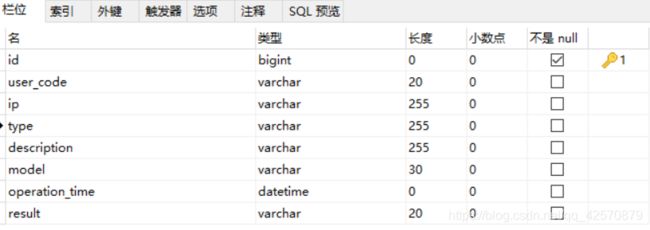SpringBoot+AOP实现用户操作日志的记录
前言:
任何一个项目都会有一个用户操作日志(也叫行为日志)的模块,它主要用来记录某个用户做了某个操作,当出现操作失败时,通过日志就可以快速的查找是哪个用户在哪个模块出现了错误,以便于开发人员快速定位问题所在。
实现这一功能一般有两种方法:
- 第一种就是很传统的做法,就是在每个模块进行插入日志的操作(不推荐),这种做法虽然实现了记录用户的操作,但很繁琐而且基本上是重复的工作。
- 第二种就是使用Spring的AOP来实现记录用户操作,也是推荐的现如今都使用的一种做法。它的优势在于这种记录用户操作的代码独立于其他业务逻辑代码,不仅实现了解耦,而且避免了冗余代码。
具体实现步骤
- 在pom.xml中添加AOP依赖
<dependency>
<groupId>org.springframework.boot</groupId>
<artifactId>spring-boot-starter-aop</artifactId>
</dependency>`
package com.example.springcloud.aop;
import java.lang.annotation.Documented;
import java.lang.annotation.ElementType;
import java.lang.annotation.Retention;
import java.lang.annotation.RetentionPolicy;
import java.lang.annotation.Target;
/**
* @author lyz
* @title: OperationLog
* @projectName springcloud
* @date 2020/9/23
* @description: 自定义操作日志注解
*/
@Target(ElementType.METHOD)//注解放置的目标位置即方法级别
@Retention(RetentionPolicy.RUNTIME)//注解在哪个阶段执行
@Documented
public @interface OperationLogAnnotation {
String operModul() default ""; // 操作模块
String operType() default ""; // 操作类型
String operDesc() default ""; // 操作说明
}
- 自定义操作日志切面类,该类是将操作日志保存到数据库
package com.example.springcloud.aop;
import com.example.springcloud.dao.OperationLogDao;
import com.example.springcloud.domain.OperationLog;
import com.example.springcloud.utils.IPUtil;
import org.aspectj.lang.JoinPoint;
import org.aspectj.lang.annotation.AfterReturning;
import org.aspectj.lang.annotation.Aspect;
import org.aspectj.lang.annotation.Pointcut;
import org.aspectj.lang.reflect.MethodSignature;
import org.springframework.beans.factory.annotation.Autowired;
import org.springframework.stereotype.Component;
import org.springframework.web.context.request.RequestAttributes;
import org.springframework.web.context.request.RequestContextHolder;
import javax.servlet.http.HttpServletRequest;
import java.lang.reflect.Method;
import java.sql.Timestamp;
import java.text.SimpleDateFormat;
import java.util.Date;
import java.util.Map;
/**
* @author lyz
* @title: OperationAspect
* @projectName springcloud
* @date 2020/9/23
* @description: 操作日志切面处理类
*/
@Aspect
@Component
public class OperationLogAspect {
@Autowired
OperationLogDao logDao;
private static SimpleDateFormat sdf = new SimpleDateFormat("yyyy-MM-dd HH:mm:ss");
/**
* 设置操作日志切入点 在注解的位置切入代码
*/
@Pointcut("@annotation(com.example.springcloud.aop.OperationLogAnnotation)")
public void operLogPoinCut() {
}
/**
* 记录操作日志
* @param joinPoint 方法的执行点
* @param result 方法返回值
* @throws Throwable
*/
@AfterReturning(returning = "result", value = "operLogPoinCut()")
public void saveOperLog(JoinPoint joinPoint, Object result) throws Throwable {
// 获取RequestAttributes
RequestAttributes requestAttributes = RequestContextHolder.getRequestAttributes();
// 从获取RequestAttributes中获取HttpServletRequest的信息
HttpServletRequest request = (HttpServletRequest) requestAttributes.resolveReference(RequestAttributes.REFERENCE_REQUEST);
try {
//将返回值转换成map集合
Map<String, String> map = (Map<String, String>) result;
OperationLog operationLog = new OperationLog();
// 从切面织入点处通过反射机制获取织入点处的方法
MethodSignature signature = (MethodSignature) joinPoint.getSignature();
//获取切入点所在的方法
Method method = signature.getMethod();
//获取操作
OperationLogAnnotation annotation = method.getAnnotation(OperationLogAnnotation.class);
if (annotation != null) {
operationLog.setModel(annotation.operModul());
operationLog.setType(annotation.operType());
operationLog.setDescription(annotation.operDesc());
}
//操作时间
operationLog.setOperationTime(Timestamp.valueOf(sdf.format(new Date())));
//操作用户
operationLog.setUserCode(request.getHeader("userCode"));
//操作IP
operationLog.setIp(IPUtil.getIpAdrress(request));
//返回值信息
operationLog.setResult(map.get("message"));
//保存日志
logDao.save(operationLog);
} catch (Exception e) {
e.printStackTrace();
}
}
}
- 在controller层的某一个方法加入@OperationLogAnnotation 注解
package com.example.springcloud.controller;
import com.example.springcloud.aop.OperationLogAnnotation;
import com.example.springcloud.domain.User;
import com.example.springcloud.service.UserService;
import io.swagger.annotations.Api;
import io.swagger.annotations.ApiOperation;
import org.springframework.beans.factory.annotation.Autowired;
import org.springframework.http.HttpRequest;
import org.springframework.web.bind.annotation.GetMapping;
import org.springframework.web.bind.annotation.PostMapping;
import org.springframework.web.bind.annotation.RequestBody;
import org.springframework.web.bind.annotation.RequestMapping;
import org.springframework.web.bind.annotation.RequestMethod;
import org.springframework.web.bind.annotation.RequestParam;
import org.springframework.web.bind.annotation.RestController;
import javax.servlet.http.HttpServletRequest;
import java.util.Map;
/**
* @author lyz
* @title: UserController
* @projectName springcloud
* @date 2020/9/12
* @description:
*/
@Api(tags = "用户表")
@RestController
@RequestMapping("/user")
public class UserController {
@Autowired
UserService userService;
@OperationLogAnnotation(operModul = "用户模块-用户列表",operType = "查询",operDesc = "查询所有用户")
@ApiOperation(value = "查询所有用户",notes = "这是用来查询所有用户列表")
@GetMapping("/users")
public Object findAll(@RequestParam(required = false)String userName,
@RequestParam(required = false)Integer sex,
@RequestParam(required = false, defaultValue = "10") int limit,
@RequestParam(required = false, defaultValue = "0") int offset,
@RequestParam(required = false, defaultValue = "createTime") String sortBy,
@RequestParam(required = false, defaultValue = "DESC") String sortFlag, HttpServletRequest request){
offset=offset/limit;
request.setAttribute("userCode","admin");
return userService.findAll(userName,sex,sortBy,sortFlag,offset,limit);
}
@OperationLogAnnotation(operModul = "用户模块-新增用户",operType = "新增",operDesc = "新增用户")
@PostMapping("/addUser")
@ApiOperation(value = "新增用户",notes = "通过这个方法可以添加新用户")
public Object createUser(@RequestBody Map<String, String>map){
return userService.save(map);
}
}

